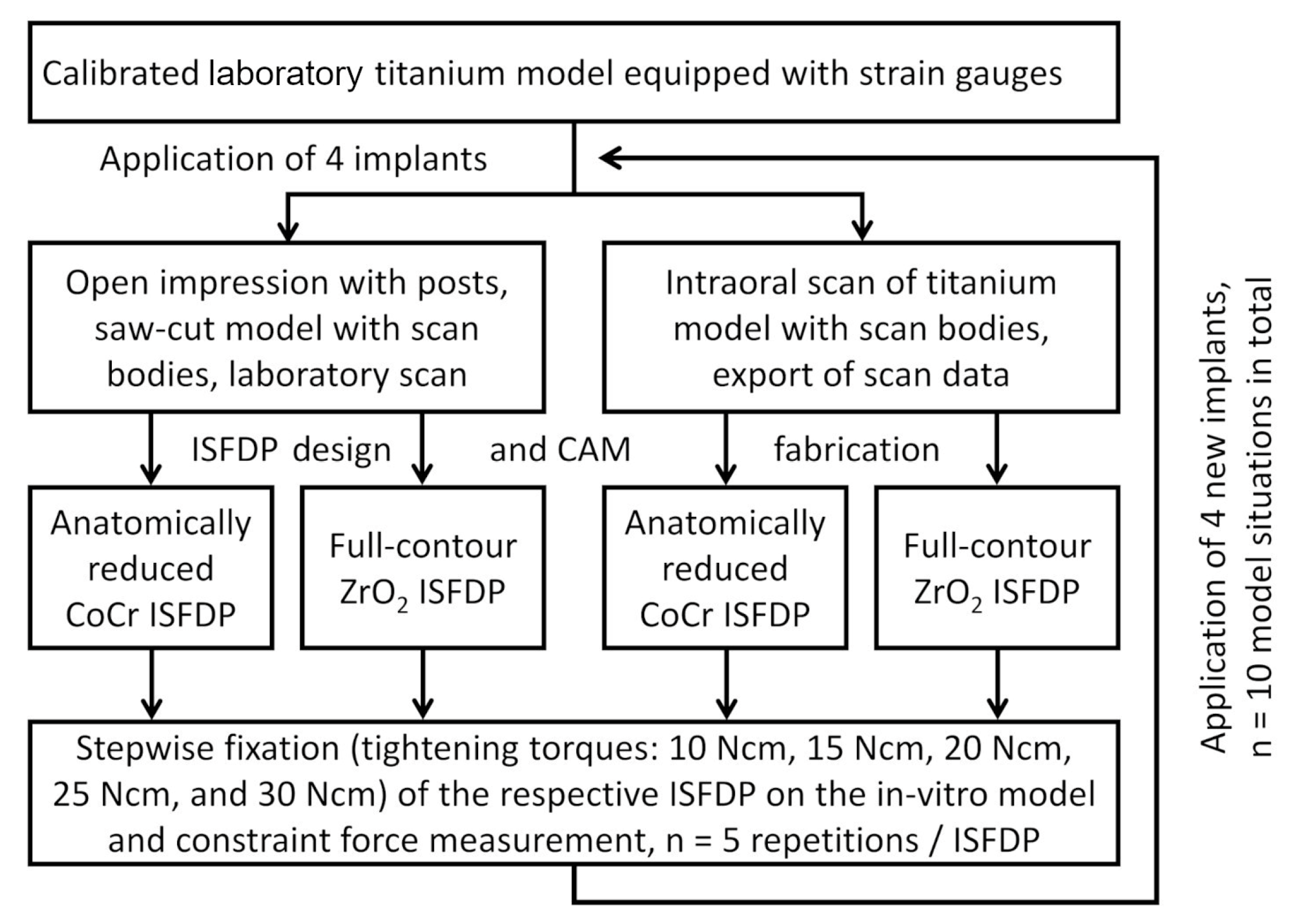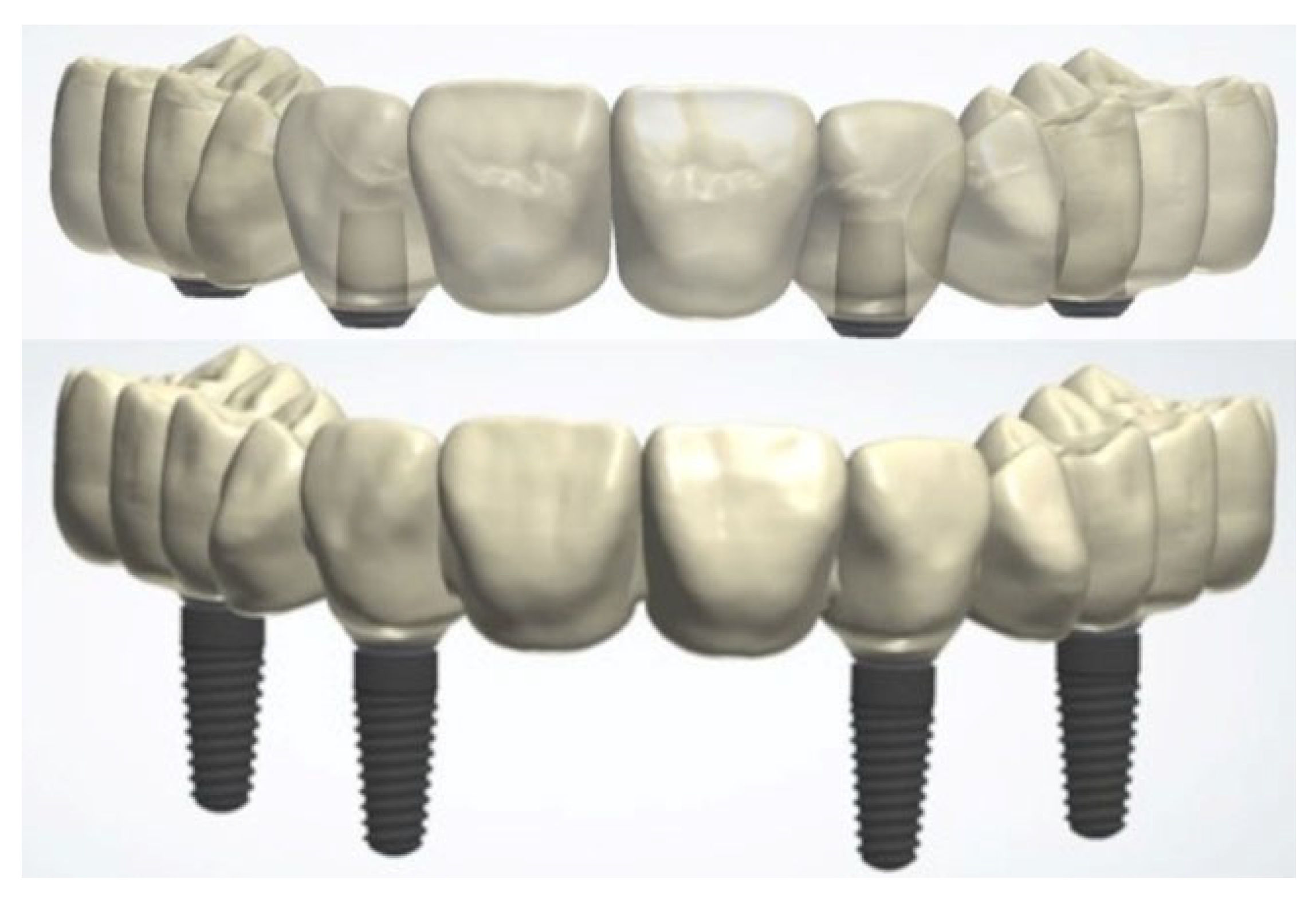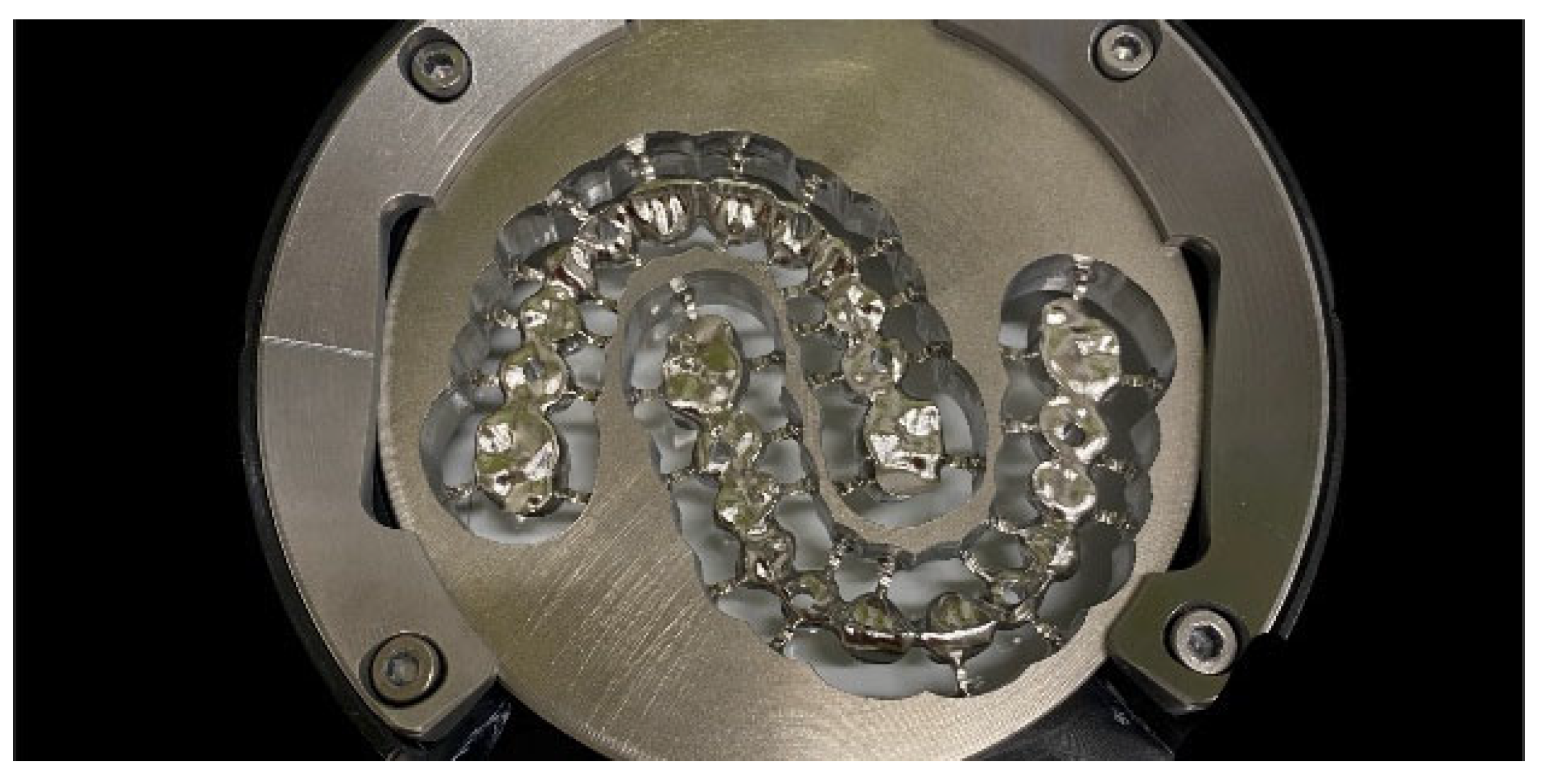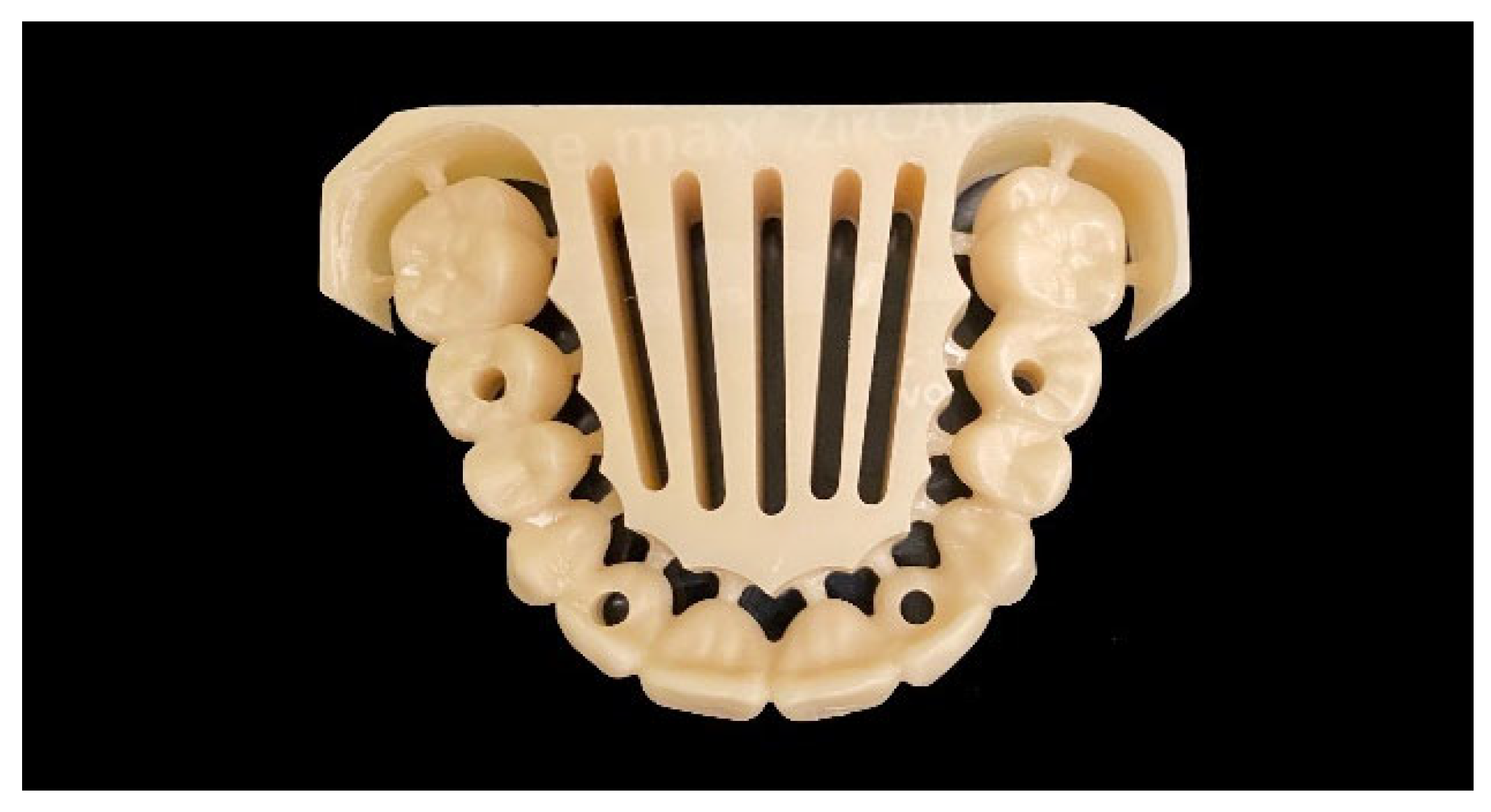Fitting Accuracy and Constraint Force Measurement of Complete-Arch Implant-Supported Fixed Dental Prostheses Made from Cobalt-Chromium and Zirconia Frameworks Based on the All-on-Four Treatment Concept
Highlights
Abstract
1. Introduction
2. Materials and Methods
2.1. Study Design
2.2. Study Model
2.2.1. Design, Manufacturing Process, and Calibration
2.2.2. Implant Fixation and Axis Alignment
2.3. Impression Techniques
2.3.1. Conventional Impression Using Polyether Material
2.3.2. Digital Impression Using an Intraoral Scanner
2.4. Design and Manufacturing of the Frameworks
2.4.1. CAD Design
2.4.2. Framework Manufacturing Process
2.5. Assessment of Fitting Accuracy by Measuring of Constraint Forces
2.6. Statistical Analysis
3. Results
3.1. Development of Constraint Forces on the Implants with Increasing Tightening Torque
3.2. Fitting Accuracy of the Restorations Depending on Impression Technique and Framework Material
4. Discussion
5. Conclusions
- Fitting accuracies of complete-arch ISFDPs made from CoCr and ZrO2 do not differ significantly.
- Implant position significantly affects absolute constraint forces in the horizontal and vertical direction and therefore affects fitting.
- Restorations made with the CI technique have better fitting accuracy and reliability than restorations made with IOS.
- Further studies are needed to confirm the presented results.
Author Contributions
Funding
Institutional Review Board Statement
Informed Consent Statement
Data Availability Statement
Acknowledgments
Conflicts of Interest
Abbreviations
| ISFDPs | implant-supported fixed dental prostheses |
| CI | conventional impression |
| IOS | intraoral scan |
| CoCr | cobalt-chronium alloy |
| ZrO2 | zirconia |
| CAD/CAM | computer-aided design/computer-aided manufacturing |
References
- Allen, P.F.; McMillan, A.S.; Walshaw, D. A patient-based assessment of implant-stabilized and conventional complete dentures. J. Prosthet. Dent. 2001, 85, 141–147. [Google Scholar] [CrossRef] [PubMed]
- Bellini, C.M.; Romeo, D.; Galbusera, F.; Taschieri, S.; Raimondi, M.T.; Zampelis, A. Francetti, L. Comparison of tilted versus nontilted implant-supported prosthetic designs for the restoration of the edentuous mandible: A biomechanical study. Int. J. Oral Maxillofac. Implant. 2009, 25, 511–517. [Google Scholar]
- Galindo, D.F.; Butura, C.C. Immediately loaded mandibular fixed implant prostheses using the all-on-four protocol: A report of 183 consecutively treated patients with 1 year of function in definitive prostheses. Int. J. Oral Maxillofac. Implant. 2012, 27, 628–633. [Google Scholar]
- Maló, P.; Rangert, B.; Nobre, M. “All-on-Four” immediate-function concept with Brånemark System implants for completely edentulous mandibles: A retrospective clinical study. Clin. Implant Dent. Relat. Res. 2003, 5, 2–9. [Google Scholar] [CrossRef]
- Maló, P.; de Araújo Nobre, M.; Lopes, A.; Francischone, C.; Rigolizzo, M. “All-on-4” immediate-function concept for completely edentulous maxillae: A clinical report on the medium (3 years) and long-term (5 years) outcomes. Clin. Implant Dent. Relat. Res. 2012, 14, 39–50. [Google Scholar] [CrossRef]
- Patzelt, S.B.; Bahat, O.; Reynolds, M.A.; Strub, J.R. The all-on-four treatment concept: A systematic review. Clin. Implant Dent. Relat. Res. 2014, 16, 836–855. [Google Scholar] [CrossRef] [PubMed]
- Kwon, T.; Bain, P.A.; Levin, L. Systematic review of short- (5–10 years) and long-term (10 years or more) survival and success of full-arch fixed dental hybrid prostheses and supporting implants. J. Dent. 2014, 42, 1228–1241. [Google Scholar] [CrossRef] [PubMed]
- Maló, P.; de Araújo Nobre, M.; Lopes, A.; Moss, S.M.; Molina, G.J. A longitudinal study of the survival of All-on-4 implants in the mandible with up to 10 years of follow-up. J. Am. Dent. Assoc. 2011, 142, 310–320. [Google Scholar] [CrossRef]
- Brånemark, P.I.; Svensson, B.; van Steenberghe, D. Ten-year survival rates of fixed prostheses on four or six implants ad modum Brånemark in full edentulism. Clin. Oral. Implants Res. 1995, 6, 227–231. [Google Scholar] [CrossRef]
- Eliasson, A.; Palmqvist, S.; Svenson, B.; Sondell, K. Five-year results with fixed complete-arch mandibular prostheses supported by 4 implants. Int. J. Oral Maxillofac. Implant. 2000, 15, 505–510. [Google Scholar]
- Heydecke, G.; Zwahlen, M.; Nicol, A.; Nisand, D.; Payer, M.; Renouard, F.; Grohmann, P.; Mühlemann, S.; Joda, T. What is the optimal number of implants for fixed reconstructions: A systematic review. Clin. Oral Implant. Res. 2012, 23, 217–228. [Google Scholar] [CrossRef]
- Gonzalez, J.; Triplett, R.G. Complications and Clinical Considerations of the Implant-Retained Zirconia Complete-Arch Prosthesis with Various Opposing Dentitions. Int. J. Oral Maxillofac. Implant. 2017, 324, 864–869. [Google Scholar] [CrossRef]
- Bidra, A.S.; Tischler, M.; Patch, C. Survival of 2039 complete arch fixed implant-supported zirconia prostheses: A retrospective study. J. Prosthet. Dent. 2018, 119, 220–224. [Google Scholar] [CrossRef]
- Tischler, M.; Patch, C.; Bidra, A.S. Rehabilitation of edentulous jaws with zirconia complete-arch fixed implant-supported prostheses: An up to 4-year retrospective clinical study. J. Prosthet. Dent. 2018, 120, 204–209. [Google Scholar] [CrossRef] [PubMed]
- R Development Core Team. R: A Language and Environment for Statistical Computing; R Foundation for Statistical Computing: Vienna, Austria, 2025. [Google Scholar]
- Wu, A.Y.; Hsu, J.T.; Fuh, L.J.; Huang, H.L. Biomechanical effect of implant design on four implants supporting mandibular full-arch fixed dentures: In vitro test and finite element analysis. J. Formos. Med. Assoc. 2020, 119, 1514–1523. [Google Scholar] [CrossRef] [PubMed]
- Katsoulis, J.; Müller, P.; Mericske-Stern, R.; Blatz, M.B. CAD/CAM fabrication accuracy of long- vs. short-span implant-supported FDPs. Clin. Oral. Implant. Res. 2015, 26, 245–249. [Google Scholar] [CrossRef]
- Al-Meraikhi, H.; Yilmaz, B.; McGlumphy, E.; Brantley, W.; Johnston, W.M. In vitro fit of CAD-CAM complete arch screw-retained titanium and zirconia implant prostheses fabricated on 4 implants. J. Prosthet. Dent. 2018, 119, 409–416. [Google Scholar] [CrossRef]
- Sahin, S.; Cehreli, M.C. The significance of passive framework fit in implant prosthodontics: Current status. Implant Dent. 2001, 10, 85–92. [Google Scholar] [CrossRef] [PubMed]
- Tiossi, R.; Gomes, É.A.; Faria, A.C.L.; Rodrigues, R.C.S.; Ribeiro, R.F. Influence of Cyclic Fatigue in Water on Screw Torque Loss of Long-Span One-Piece Implant-Supported Zirconia Frameworks. J. Prosthodont. 2017, 26, 315–320. [Google Scholar] [CrossRef]
- Ahlholm, P.; Sipilä, K.; Vallittu, P.; Jakonen, M.; Kotiranta, U. Digital Versus Conventional Impressions in Fixed Prosthodontics: A Review. J. Prosthodont. 2018, 27, 35–41. [Google Scholar] [CrossRef]
- Waldecker, M.; Rues, S.; Rammelsberg, P.; Bömicke, W. Accuracy of complete-arch intraoral scans based on confocal microscopy versus optical triangulation: A comparative in vitro study. J. Prosthet. Dent. 2021, 126, 414–420. [Google Scholar] [CrossRef]
- Rammelsberg, P.; Lorenzo-Bermejo, J.; Kappel, S.; Meyer, A.; Zenthöfer, A. Long-term performance of implant-supported metal-ceramic and all-ceramic single crowns. J. Prosthodont. Res. 2020, 64, 332–339. [Google Scholar] [CrossRef]
- Horsch, L.; Kronsteiner, D.; Rammelsberg, P. Survival and complications of implant-supported cantilever fixed dental prostheses with zirconia and metal frameworks: A retrospective cohort study. Clin. Implant. Dent. Relat. Res. 2022, 24, 621–629. [Google Scholar] [CrossRef]
- Laumbacher, H.; Strasser, T.; Knüttel, H.; Rosentritt, M. Long-term clinical performance and complications of zirconia-based tooth- and implant-supported fixed prosthodontic restorations: A summary of systematic reviews. J. Dent. 2021, 111, 103–723. [Google Scholar] [CrossRef] [PubMed]
- Larsson, C.; Vult Von Steyern, P. Implant-supported full-arch zirconia-based mandibular fixed dental prostheses. Eight-year results from a clinical pilot study. Acta Odontol. Scand. 2013, 71, 1118–1122. [Google Scholar] [CrossRef] [PubMed]
- Abduo, J.; Lyons, K. Effect of vertical misfit on strain within screw-retained implant titanium and zirconia frameworks. J. Prosthodont. Res. 2012, 56, 102–109. [Google Scholar] [CrossRef]
- Papaspyridakos, P.; Barizan Bordin, T.; Natto, Z.S.; El-Rafie, K.; Pagni, S.E.; Chochlidakis, K.; Ercoli, C.; Weber, H. Complications and survival rates of 55 metal-ceramic implant-supported fixed complete-arch prostheses: A cohort study with mean 5-year follow-up. J. Prosthet. Dent. 2019, 122, 441–449. [Google Scholar] [CrossRef] [PubMed]
- Rammelsberg, P.; Meyer, A.; Lorenzo-Bermejo, J.; Kappel, S.; Zenthöfer, A. Long-term chipping and failure rates of implant-supported and combined tooth-implant-supported metal-ceramic and ceramic fixed dental prostheses: A cohort study. J. Prosthet. Dent. 2021, 126, 196–203. [Google Scholar] [CrossRef]
- Ayna, M.; Jepsen, S. A Retrospective Evaluation of 5 Years of Clinical Results of Metal-Ceramic vs. Monolithic Zirconia Superstructures in Maxillary All-on-4TM Concept. J. Clin. Med. 2024, 13, 557. [Google Scholar] [CrossRef]
- Waltenberger, L.; Bishti, S.; Wolfart, S. German S3 guideline on implant-supported all-ceramic restorations. Int. J. Implant. Dent. 2025, 11, 53. [Google Scholar] [CrossRef]
- Papaspyridakos, P.; Chen, Y.W.; Gonzalez-Gusmao, I.; Att, W. Complete digital workflow in prosthesis prototype fabrication for complete-arch implant rehabilitation: A technique. J. Prosthet. Dent. 2019, 122, 189–192. [Google Scholar] [CrossRef] [PubMed]
- Bevilacqua, M.; Tealdo, T.; Menini, M.; Pera, F.; Mossolov, A.; Drago, C.; Pera, P. The influence of cantilever length and implant inclination on stress distribution in maxillary implant-supported fixed dentures. J. Prosthet. Dent. 2011, 105, 5–13. [Google Scholar] [CrossRef] [PubMed]
- Dayan, S.C.; Geckili, O. The influence of framework material on stress distribution in maxillary complete-arch fixed prostheses supported by four dental implants: A three-dimensional finite element analysis. Comput. Methods Biomech. Engin. 2021, 24, 1606–1617. [Google Scholar] [CrossRef] [PubMed]









| Absolute Horizontal Constraint Forces | |||||
|---|---|---|---|---|---|
| Predictors | Estimates | 95% CI | p | ||
| ISFDP material | Reference: CoCr | ZrO2-ref | −0.77 | −1.91 to 0.37 | 0.184 |
| Impression technique | Reference: CI | IOS-ref | 0.74 | −2.02 to 3.50 | 0.599 |
| Implant position | Reference: Pos 15 | Intercept | 4.75 | 2.49–7.01 | <0.001 |
| Pos 12-ref | 2.57 | 0.95–4.18 | 0.002 | ||
| Pos 22-ref | −1.10 | −2.71 to 0.51 | 0.178 | ||
| Pos 25-ref | 0.83 | −0.79 to 2.44 | 0.313 | ||
| Reference: Pos 12 | Intercept | 7.32 | 5.06–9.58 | <0.001 | |
| Pos 22-ref | −3.67 | −5.28–2.06 | <0.001 | ||
| Pos 25-ref | −1.74 | −3.35 to −0.13 | 0.034 | ||
| Reference: Pos 22 | Intercept | 3.65 | 1.39–5.91 | 0.002 | |
| Pos 25-ref | 1.93 | 0.32–3.54 | 0.019 | ||
| σ2 | 13.30 | ||||
| τ00 | 8.10 | ||||
| ICC | 0.38 | ||||
| Marginal R2 Conditional R2 | 0.089 0.434 | ||||
| Absolute Horizontal Constraint Forces | |||||
|---|---|---|---|---|---|
| Predictors | Estimates | 95% CI | p | ||
| ISFDP material | Reference: CoCr | ZrO2-ref | −0.01 | −1.02 to 1.00 | 0.981 |
| Impression technique | Reference: CI | IOS-ref | 3.23 | 0.66–5.81 | 0.014 |
| Implant position | Reference: Pos 15 | Intercept | 2.17 | 0.09–4.25 | 0.041 |
| Pos12-ref | 2.46 | 1.03–3.89 | 0.001 | ||
| Pos 22-ref | 2.17 | 0.74–3.60 | 0.003 | ||
| Pos 25-ref | 0.54 | −0.89–1.97 | 0.454 | ||
| Reference: Pos 12 | Intercept | 4.63 | 2.55–6.71 | <0.001 | |
| Pos 22-ref | −0.29 | −1.72 to 1.14 | 0.686 | ||
| Pos 25-ref | −1.92 | −3.35–−0.49 | 0.009 | ||
| Reference: Pos 22 | Intercept | 4.34 | 2.26–6.42 | <0.001 | |
| Pos 25-ref | −1.63 | −3.05–−0.20 | 0.026 | ||
| σ2 | 10.46 | ||||
| τ00 | 7.19 | ||||
| ICC | 0.41 | ||||
| Marginal R2 Conditional R2 | 0.174 0.511 | ||||
Disclaimer/Publisher’s Note: The statements, opinions and data contained in all publications are solely those of the individual author(s) and contributor(s) and not of MDPI and/or the editor(s). MDPI and/or the editor(s) disclaim responsibility for any injury to people or property resulting from any ideas, methods, instructions or products referred to in the content. |
© 2025 by the authors. Licensee MDPI, Basel, Switzerland. This article is an open access article distributed under the terms and conditions of the Creative Commons Attribution (CC BY) license (https://creativecommons.org/licenses/by/4.0/).
Share and Cite
Horsch, L.; Kirsch, C.; Zenthöfer, A.; Rammelsberg, P.; Richter, K.; Rues, S. Fitting Accuracy and Constraint Force Measurement of Complete-Arch Implant-Supported Fixed Dental Prostheses Made from Cobalt-Chromium and Zirconia Frameworks Based on the All-on-Four Treatment Concept. Materials 2025, 18, 4398. https://doi.org/10.3390/ma18184398
Horsch L, Kirsch C, Zenthöfer A, Rammelsberg P, Richter K, Rues S. Fitting Accuracy and Constraint Force Measurement of Complete-Arch Implant-Supported Fixed Dental Prostheses Made from Cobalt-Chromium and Zirconia Frameworks Based on the All-on-Four Treatment Concept. Materials. 2025; 18(18):4398. https://doi.org/10.3390/ma18184398
Chicago/Turabian StyleHorsch, Laura, Cedric Kirsch, Andreas Zenthöfer, Peter Rammelsberg, Kevin Richter, and Stefan Rues. 2025. "Fitting Accuracy and Constraint Force Measurement of Complete-Arch Implant-Supported Fixed Dental Prostheses Made from Cobalt-Chromium and Zirconia Frameworks Based on the All-on-Four Treatment Concept" Materials 18, no. 18: 4398. https://doi.org/10.3390/ma18184398
APA StyleHorsch, L., Kirsch, C., Zenthöfer, A., Rammelsberg, P., Richter, K., & Rues, S. (2025). Fitting Accuracy and Constraint Force Measurement of Complete-Arch Implant-Supported Fixed Dental Prostheses Made from Cobalt-Chromium and Zirconia Frameworks Based on the All-on-Four Treatment Concept. Materials, 18(18), 4398. https://doi.org/10.3390/ma18184398







